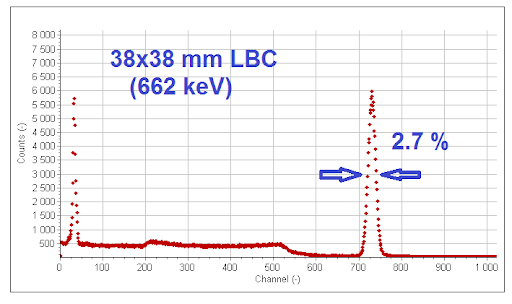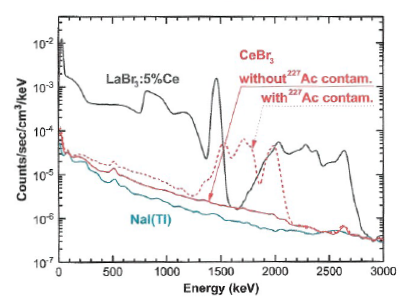July 25th, 2022 - Screening baggage and Personnel
Detector Properties
Effective screening requires high efficiency detectors for the detection of X-rays and gamma-rays. These detector materials require a high density and high effective Z (number of protons per atom). Today inorganic scintillation crystals can meet the requirements for high stopping power and optical transparency. These high Z detectors have densities which makes them suitable for X and ɣ-ray energies over a large dynamic range (~14 keV to 3 MeV).
Comparing Densities of Two Familiar Detectors
Sodium iodide (NaI(Tl) is 3.67 g/cm3 and cerium bromide (CeBr3) [1] is 5.1 g/cm3. When considering that stopping power goes as Z2 this becomes a large difference between these two detector materials. These detectors are also spectroscopy grade which provide good resolution for radioisotope identification.
An example of excellent resolution is shown below.

Lanthanum Bromo Chloride(LBC) - LaBr2.85Cl0.15:Ce
LBC [1] scintillators have a high energy resolution of ~ 3% FWHM at 662 keV. This material is a little stronger than Lanthanum Bromide (LaBr3), however, resolution is not the greatest concern for scanning baggage and personnel. The ultimate efficiency is obtained with the selection of CeBr3 detectors. CeBr3 material outperforms lanthanum-based materials even though the resolution is somewhat compromised at about 4%. However, 4% is still quite adequate for most radioisotope identification. This outstanding performance is achieved because of the low intrinsic background of CeBr3 which is a factor of more than 100 lower in some parts of the spectrum (affecting both low and high energies) compared to LaBr3 [2] [3]. CeBr3 is readily available in sizes up to 76x76 mm (3x3 inches). The background affecting LaBr3 detectors is seen in the chart below. The background affecting lanthanum material is from a 138La contaminant (note the log scale showing background counts).

LaBr3 background from 138La Contamination
The severity of the high background which results in a large loss of sensitivity may not be appreciated. Let’s illustrate by placing a Cesium-137 (137Cs) source near the detector to perform a calibration and then take a background while forgetting to remove the 137Cs source (of course no one has ever done this – at least on purpose). The result is a large loss of sensitivity at the 137Cs energy line (662 keV) with great difficulty in identifying or even seeing a 137Cs peak when searching. Now picture this loss of sensitivity across the entire spectrum from a high intrinsic background with LaBr3. This is the primary reason for the selection of CeBr3 in giving the best performance for screening applications.
References
[1] Scionix.nl detectors available through BNC (U.S. Rep)
[2] P. Schotanus, et. al., Nuclear Instruments and Methods in Physics Research A 729 (2013) 596
[3] James McQuaid, The Performance of CeBr3 Detectors, BNC Website
